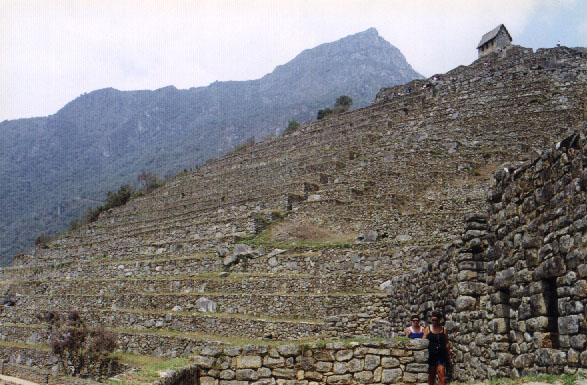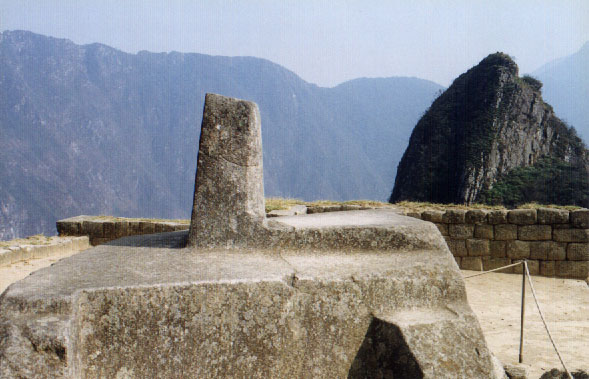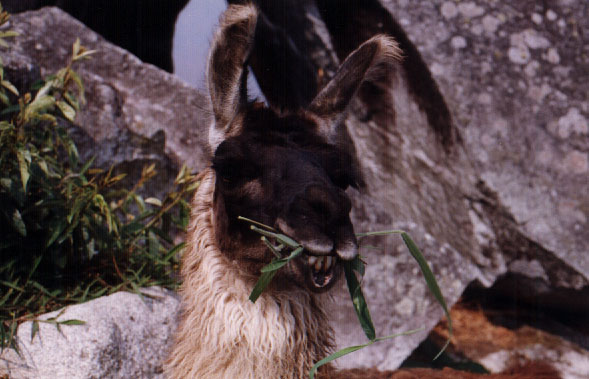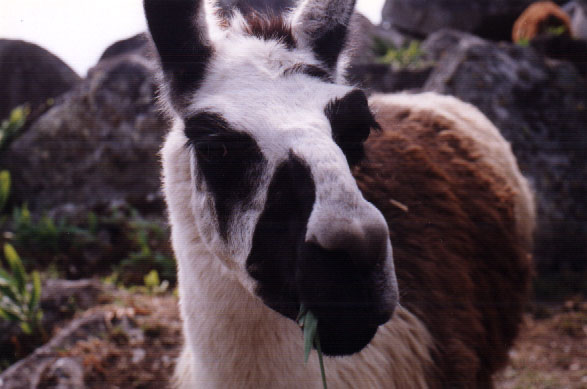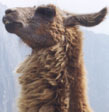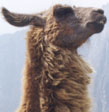The three llamas started to climb through the quarry and work their way towards better grass. As always, they had little patience for us and our cameras and went on their merry way down the rocky path.
Once again we returned to the terrace below the Caretaker's Hut in order to get some black and white golden shots (I suppose that might be a bit of a contradiction; so be it). The sun continued its upward track in the sky; I wondered if the light would be too hazy. Susanne experimented with her color filters. "Will the filters provide contrast in black and white?" I asked. "I sure hope so," she responded. As Susanne took her pictures I noticed that the llamas were now in the middle of the main plaza, far below the terraces. "Smart llamas," I said. "Lots of yummy grass there. I hope they don't get swamped by tourists, though." Indeed, they better have been prepared, for I could see the first tour groups of the morning entering through the main gate and walking along the path far below us.
"Let's go sit under the tree," I suggested. A lone tree stood amongst a grassy area not far from the main plaza. On most occasions I'd noticed groups of contented visitors napping below the tree. It seemed like a great spot. Susanne agreed so we retreated down the stone path, descending to the plaza level. The tree, indeed, provided much needed shade, especially during the humid haze of late morning. Unfortunately the grass played host to thousands of gnats and black flies which began to swarm around our heads as soon as we got settled against the tree. "This isn't going to work," I said, swatting black flies away from my eyes. In the last two days I had managed to avoid any bites save a couple on my left wrist and elbow; I didn't want to give these pests any more opportunities than they deserved. Susanne seemed even more annoyed with the flies than I did, so she happily agreed to move on as quickly as possible.
Meanwhile, the three llamas occupied center stage in the main plaza. Several groups totaling around 25 people had settled along the edge of the plaza to watch the llamas' antics (or lack thereof). Francisco, though, became eager to put on a show with the arrival of a stray dog. The dog appeared to be a collie mutt of some sort; he enthusiastically demonstrated his genetic predisposition for herding sheep by charging around the llamas, barking out orders every few seconds. Clothilde and Mathilde blissfully ignored the dog but Francisco was in no mood for such bossiness. The brown llama lowered his neck until it was parallel to the ground and trotted quickly towards the dog. The collie, not anticipating a fight, backed off for a moment but then charged Francisco in a show of bravado. Francisco was not amused; once again he lowered his neck in a threatening post and hissed at the dog.
Francisco and the dog's game of brinkmanship continued as the crowd grew larger. No one knew exactly what to do; many of the tourists were probably here on a day trip and wanted an obligatory pose with a llama, but it would hard to get all three llamas to perform on queue as long as one of them was busy sparring with an irate mutt. "When llamas attack!" I mocked. "I wonder how many tourists get killed getting in the way of a llama scorned." Susanne got into the action, stalking both animals like a veteran wildlife photographer. Clothilde and Mathilde, sadly, were subjected to the whims of the crowd as each tourist tried to get their prized llama picture. "Seymour!" I heard one woman yell with a heavy Long Island accent, "take the goddamn picture already! Take the picture of me and the llama!" The chaos was too much for us. We retreated to a large boulder on the far side of the plaza and relaxed in peace, knowing full well our time at Machu Picchu was nearing an end.
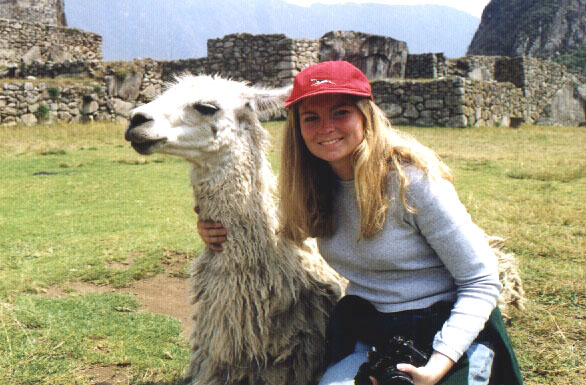 |
| Susanne hangs out with Mathilde the Llama |
Our train wouldn't depart for Cusco until 4pm, which meant most people would depart on the 3pm bus back to Aguas Calientes. We had seen how chaotic things got when all the tourists tried to catch the last possible bus yesterday, so Susanne and I agreed to return to the village a little early, perhaps around 2pm, so we could avoid the last minute rush. Noon was approaching, so there was just enough time for one last climb up to the Caretaker's Hut to bid farewell to Machu Picchu.
I stood atop my favorite boulder, the spot where I had sat yesterday and sketched my pastel drawing of the ruins. It was the same view I had seen at least half a dozen times over the past three days, but now something seemed different. Machu Picchu carries itself with a sort of intangible timelessness, a perfect blending of earth and sky. With so much of the ruins hewn out of the living rock, I could only imagine how long into the future these structures will last. As long as the mountains themselves, I hoped. But as far as my experience was concerned, each passing second was just another lost moment until the time when I would have to say goodbye to this view, when Machu Picchu as a living and breathing experience would come to an end.
Saying goodbye to a magical place is never easy. I had struggled to stretch out my last glimpse of Angkor Wat last year just as I had done previously at the ruins of Petra and Luxor, or the great Buddhist temples of Bodnath and Swayumbunath in Kathmandu. The memories will last forever, of course, but the moment during which you can feel yourself as part of these surroundings is fleeting at best. Susanne and I stared out upon Machu Picchu as we made our way down the terraces, practically walking backwards along the stone path leading to the park exit. Sometimes you just have to walk away, I guess. I took one last look, my mind embracing it for eternity. Until next time, Machu Picchu.
Out by the hotel snack bar, I once again purchased a hamburger and coke for lunch. At least today I didn't have to scrape the grime of Huayna Picchu off my hands before eating. Susanne settled down inside the restaurant, where a band of Andean musicians was performing. They were pretty good, playing with a variety of zampoñas (pan flutes), guitars, charangos and flutes. As I sat down with Susanne they broke out into "El Condor Pasa," perhaps the best known Andean tune thanks to Simon and Garfunkel. It's a pretty song that I've always liked but in the last several I've heard at least a dozen different interpretations of it, from classical strings to traditional pan flutes to marching brass band. And no matter how authentically Andean a particular version was, I would always regress to Simon and Garfunkel: "I'd rather be an hammer than a nail, yes I would..." I kept expecting to hear the Quechua musicians to start singing "Aquí está a usted, Señora Robinson; Jesus le ama más que usted sabria (wa wa wa)..." Instead they played a slow rendition of the Beatles' "Hey Jude," which worked surprisingly well with the pan flute accompaniment.
Not long after the musicians passed the hat and packed up their instruments we bumped into our guide Francisco, who appeared to have just finished giving another tour. Susanne proudly told him we climbed Huayna Picchu. "You see!" he exclaimed, "I told you that you could do it!" We neglected to tell him how long it took us, of course.
"Are you two on honeymoon?" Francisco then asked.
"No," Susanne replied, "we're just traveling for our annual vacation."
"That's good," he responded. "Machu Picchu isn't really a honeymoon place. Go to the Caribbean, or to Colombia."
"Colombia?," I asked, a little surprised at his suggestion.
"Lots of dancing, lots of salsa," Francisco continued, shaking his shoulders and hips as he closed his eyes, biting his lower lip as if he were in the midst of a brief flashback of some sort.
"Have you ever visited the United States?" Susanne asked, changing the subject away from honeymoons.
"No, not yet," he replied. "It's not easy for Peruvians to get a US visa. You must get it through a travel agent, so you need a credit card. I don't have a credit card, so it's very difficult for me to get a visa. It's too bad; I've always wanted to visit your Indian reservations, in the Dakotas, in New Mexico..."
I was somewhat surprised by his interest in visiting the reservations; perhaps the Quechua in him wanted to compare Peruvian Indian life to native American life in the States. I gave him my business card with our addresses written on back, just in case he'd ever visit America or wanted a reference. We then said goodbye to Francisco, thanking for his insight, before boarding the 2pm bus to Aguas Calientes.
Susanne and I talked about Francisco as we waited for the bus' departure. "I wonder what kind of reception he would receive in America," I asked. "His English is excellent, he's smart, but you've got to wonder if he'd be treated as just another immigrant." I'd told him after his Colombia comments he would probably like Miami for its lively pan-American cultural scene, but Susanne later said, "It's really a shame that there are so many places in the States that would treat him like an outsider, that he might only feel welcome in Miami or New York." I really hoped that wasn't the case, but knowing our country's attitudes towards Hispanic immigration, I wouldn't be surprised if he encountered problems as a tourist there. "I still hope he gets the chance, though," Susanne said.
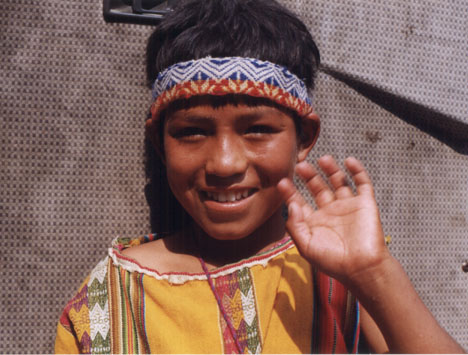 |
The Oooh-paaaah boy, Aguas Calientes
|
As the bus drove us down from the top of the mountain we were once again greeted by a small Quechua boy yelling "Oooh-paah!" on the side of the road. Most of the people on our bus were probably taking their first trip down the mountain because they were surprised by his appearance at each bend along the road. A Norwegian man next to me pulled out his video camera halfway down. "Why not?" he said to me with a shy smirk. Once we reached the bottom of the road our driver invited the boy on the bus to collect tips. I don't think he was the same kid as yesterday - we'd have to get a picture of him for comparison. As the boy made his way to the back of the bus, the members of a large group of Japanese tourists each pulled out one or more dollar bills for the boy; I think I even saw him get a five-spot from someone. "This must be an age-old tradition for local kids," I said. "Great way to make some money and stay fit." Susanne took a picture of the boy as we exited the bus.
A small crowd of Quechua women and girls quickly surrounded us, offering last minute purchases of t-shirts, postcards, and framed butterfly collections. Susanne and I squeezed through the crowd and made a quick visit to the village's Plaza Manco Capac so I could get a picture of Avenida Pachacutec, the ever-rising pedestrian boulevard where we had spent our free time at night. We then walked along the train tracks to one of Aguas Calientes' many outdoor cafes. We had about an hour to kill before going to the train station so we each ordered a soda and relaxed on a picnic bench. A large grasshopper shaped like a green leaf jumped onto my backpack and joined us for a while. "A little piece of the Amazon," I said. Soon we spotted Angus once again, walking our way with his luggage. He joined us and talked about his morning adventure up Huayna Picchu. I couldn't believe he climbed both local mountains in two days. "You're a braver soul than we are," I told him.
Around 3pm we walked over to the Aguas Calientes train station. The orange and yellow tourist train was already there but we weren't allowed to board for another 15 minutes. As we settled into the train Angus offered us a copy of a recent issue of Newsweek, a Bill Clinton Presidential Scandal Special Edition. "Keep it," he said. "I've already read it." "And probably already sick of it," I replied, smiling.
The train departed on time at 4pm. The trip would take us about four and a half hours, which was unfortunate because I really wanted to get back to Cusco before 8pm in or to talk with our travel agent. We had purchased tomorrow's Cusco-to-Puno train tickets at the same agency that handled our Machu Picchu tickets. We hadn't actually received our Puno tickets yet; considering the minor foul-up we had during our departure from Cusco three days earlier, I was more than a little nervous about securing our arrangements for tomorrow. If we got in after 8pm, the office would be closed and we'd just have to hope for the best Friday morning.
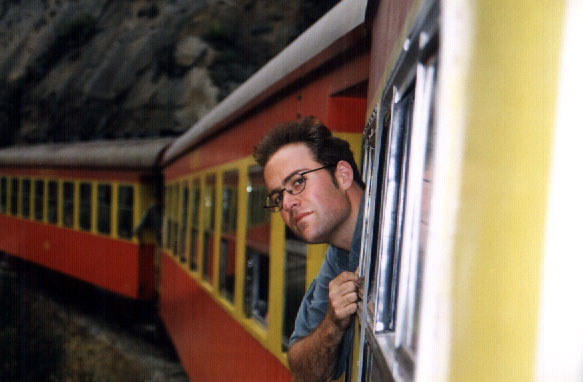 |
Hanging out the window on the train to Cusco
|
The late afternoon passed quickly on the train. Susanne and I both had some fun with our cameras by hanging out the window and getting pictures of each of us doing the same from another window. The rest of the train probably though we were being a little silly; I certainly felt so after I bumped the top of my head on the window after ducking in to avoid a fast approaching tree branch. Around 7pm we suddenly saw the bright lights of Cusco's Plaza de Armas below us. I wondered if we were arriving a little early. We soon began the series of four switchbacks that would zig-zag us slowly to the valley floor. The switchbacks during our departure from Cusco hadn't taken more than half an hour - perhaps we would have time to stop at the travel agency before 8 o'clock after all.
The train pulled into Cusco station just after 7:30. There were no signs of our free ride back to our hotel, probably because we were so ahead of schedule. Not wanting to waste any time, Susanne and I jumped into the first available minibus to catch a three sole ride to the Plaza de Armas. In our haste, though, we neglected to say goodbye to Angus, who was standing on the train platform looking for his ride. I felt bad about that, but considering his next stop was Easter Island I figured he wouldn't lose too much sleep about it.
The minibus dropped us along the southern edge of the plaza, a few storefronts away from the tour agency. I was relieved to see they were still open so we went inside and inquired about our Puno tickets. "Don't worry," they told us, "Carlos will come by tomorrow at 7:15am with your tickets." Unfortunately that's the same thing we were told for Machu Picchu. There was little I could do since no one at the agency had our tickets on hand, and Luis Guillen wasn't anywhere to be found. As we departed the agency to return to Hostal Loreto, though, Luis appeared out of nowhere and came running after us. "Don't worry about Puno," he said. "I have your tickets at home. I've been out of the office all day on a Sacred Valley tour. I will come by with the tickets at 7:15am."
Now that the ticket issue was settled, Susanne and I returned the hotel. Our friend the manager was there to greet us. "You liked Machu Picchu?" he asked. "Yes, very much," we both said in unison. We dropped our bags in our new room before returning to the Plaza de Armas in search of a nightcap of maté de coca and some breakfast snacks for tomorrow's train ride. Next to the Loreto we entered Norton Rat's, a popular local pub. We relaxed to the sounds of the Beatles' Magical Mystery Tour as an American expat brought over our teas. All the other customers were Peruvian but the pub had a decidedly North American feel to it: a wall covered with Arizona license plates, Green Bay Packers and Fighting Irish stickers, a "Leo Koetke in Concert" poster. Small world - one of my closest friends from college was hometown best friends with Leo Koetke's daughter. I'd have to tell her about the poster.
After leaving Norton Rat's we returned to the plaza to shop for tomorrow's breakfast. Our favorite morning café was still open so I purchased four caramel pastry sticks as well as what appeared to be a cone-shaped puff pastry filled with chocolate. "Oh, that looks sinnnnfullll," I drooled. We didn't plan to get dinner so I gluttonously concluded that the puff pastry could serve as an acceptable substitute. My sweets craving got the best of me, though, when I discovered the "chocolate" inside the puff pastry was actually a huge, gooey glob of caramel. Delicious, but I could feel the button pop off my pants as I finished it.
We had only intended to step out to buy our breakfast snacks, but as we walked across the plaza we realized this would be our last taste of Cusco. "Let's walk around the market one more time," I said. The perimeter of the plaza was packed with campesinas selling wool goods, shopping tourists, strolling couples stretching out a romantic evening, hordes of kids heading to the video arcade. We turned south from the plaza and continued along another row of market stalls. I found a Quechua woman selling alpaca wool slippers. "Those look so warm," I said. I asked her how much she was selling them for. "Treinta soles," she said, about 10 dollars a pair. None of the pairs had American shoe sizes listed so I tried on two sets before finding ones that fit well. "Very nice," I said, "but too expensive. Diez soles." "Diez soles!" she laughed, mocking my offer in Spanish. "Veinte soles." Twenty wasn't bad. We bantered back and forth for a few moments before finally settling on an agreeable price. "Diez-y-ocho, señor." "Ok, 18 soles." For six dollars I'd have the most comfortable slippers on the north side of the Andes this winter, if they only lasted that long. Susanne also discovered a small Quechua rug hanging which she also bought from the same woman.
Further around the corner we discovered an artists' cooperative in which a dozen or so artesenias sold their work. Though I had no real intention of buying anything inside I discovered an amazing piece of pottery depicting an old campesino drinking from a ceremonial cup. "For drinking chicha," said the shop owner, in reference to the local Quechua homebrew found all over Peru and Bolivia. I had promised my mom I'd try to find her some native pottery in either Cusco or La Paz, and this pottery was the first piece I'd seen that had struck my interest. After some brief haggling the campesina wrapped up the pottery in a neatly tied roll of string and newspaper. "I have no idea how I'll get this home in once piece," I wondered aloud. "Wrap it in a t-shirt," Susanne said, which reminded me I needed to buy a t-shirt or two just so I'd have an extra set of clothes along the way. Most of the t-shirts I'd seen in town featured crude cartoons of llamas spitting on campesinos or gaudy prints of Machu Picchu, but I soon found one shirt with a trio of llamas and "Cusco, Peru" tastefully printed on the bottom. I grabbed up the t-shirt for eight soles. "We better get going before I spend any more money," I said.
As we settled into the Hostal Loreto for the night, Susanne and I pondered what time we needed to be up in the morning. "Luis is picking us up at 7:15, right?" Susanne asked. "Actually, I thought he was just dropping off our tickets at that time," I replied, admittedly confused, since our Lonely Planet book listed the Cusco-to-Puno train as departing at 9am, not 8am.
"I'll get up before 7am and check with the hotel staff," I promised. "How do you say, 'What time does the Puno train depart?'"
"Cuando el trén para Puno sale," Susanne said, rolling it off her tongue as if she was expecting to ask someone the question at that very moment.
"Cuando el trén para Puno sale, cuando el trén para Puno sale," I repeated. "I can remember that. Hope you don't mind me waking you up if I forget."
"Cuando el trén para Puno sale...." I said to myself as Susanne shut out the small light on the bed stand.

